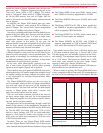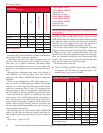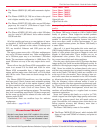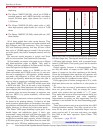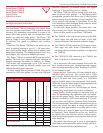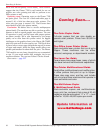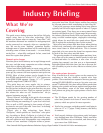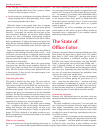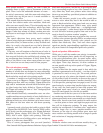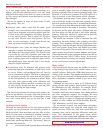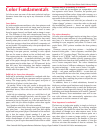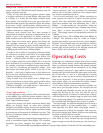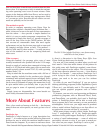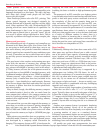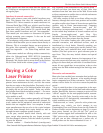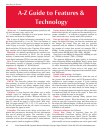
The Color Laser Printer Guide: Industry Briefing
Entire Contents © 2006 Progressive Business Publications. Copying of Pages Prohibited.To Order: 800 247 2185 or www.betterbuys.com 59
many people overlook — namely, the time it takes for
computer users to apply color to documents in the first
place. There is also an undeniable element of waste —
the trivial, unnecessary, and often non-work-related uses
to which color can be put once it is made available to
everyone in the office.
The second objection has been one of speed — no mat-
ter how fast vendors made color machines, black-and-
white ones were usually faster. This relationship was due
to mainstream color laser technology, which lays down
black-and-white four times as fast as it does full-color
images. Under that scheme of things, vendors were ask-
ing buyers to wait longer for their work, as well as to pay
more for it.
But speed objections have pretty much vanished.
Printers using single-pass tandem technology are able to
print color as fast, or almost as fast, as they do black-and-
white. As a result, color speeds are very fast by historical
standards, and their black-only speeds are also quite
acceptable.
To be sure, cost will continue to limit the use of color in
the office for some time. But as vendors develop printers
that are good for both color and black-only printing, they
ar
e overcoming these limitations. A likely vision for the
office of the future is one where most printers are capa-
ble of color but are not always used for that purpose.
The twin-missions concept
As we’ve explained, manufacturers are now offering a
number of models that are designed to more adequately
meet the twin missions of ca
tering to both plain-vanilla
black-and-white work and color printing needs.
A number of models now have black-only speeds over
15ppm,
even up to 28ppm or 38ppm. That’s a significant
number given that, until very recently, 25ppm defined the
high end of mainstream network black-and-white print-
ing (that barrier has lately shifted to 35ppm or 45ppm,
but 25ppm still marks the start of “fast” workgroup and
de
partmental printing).
And whereas black-only consumables costs on color-
capable machines were previously at least double those of
r
e
gular monoc
hr
ome laser printer
s, today the cost of
printing in black on a color machine can be more reason-
a
b
le (more on this later when we talk about operating
costs).
A network-ready color laser that’s able to print in black
a
t 30ppm (lik
e the $999 HP Color LaserJ
et 3000) is ef
f
ec
-
tively giving you the performance of a 30ppm dedicated
black-only printer costing $550 (like the HP LaserJet
2420).
And it adds 15ppm color printing. What this
means is that the cost of adding color to your workgroup
printer is, in this case, about $450.
This
,
of
cour
se, presupposes that you need (another)
b
lack-and-white printer. And the key to growing this mar-
ket is persuading people to buy color instead of black-
only when they need new printers rather than asking
them to go out and buy specialized printers in addition to
the ones they have.
Under this scenario, people in an office would have
access to color when they need it but would be able to
print in black-and-white when speed and cost are more
important than appearance. What’s more, color would
often be used only in a limited way — to highlight head-
lines, for example — rather than to print the endless pho-
tos and full-color business graphics that tend to be fea-
tured so heavily in printer vendors’ samples.
Still, vendors have some way to go before they can real-
ly deliver color printers that also fulfill a no-compromises
monochrome mission. Typically, color printers are far
bulkier than black-only ones. And even when engine
speeds are similar, paper-handling capabilities are gener-
ally more limited on comparable-speed color printers.
Speed and pr
oduct differentiation
While price is still the number one priority in manufac-
turers’ development plans, speeds are still improving, as
is the price/performance ratio. As stated earlier, entry-
level and midmar
ket models once had top color speeds of
only 4ppm. These days, however, it’s more common to
see new models with top color speeds of 12ppm, 20ppm,
or even 30ppm+.
Keep in mind that the engine speed is that which the
machine is guaranteed not to exceed — not that which it
is pr
omised to r
each on e
very job. The actual perform-
ance y
ou get out of a printer also depends on the ability
of the printer’s built-in controller to process the types of
jobs y
ou send and the amount of
memory installed. Also,
it is the speed for printing letter-size pages, even if it is the
speed rating for a printer that handles ledger-size output.
In any case, the rated speed for laser-class printers will
correspond much more closely to actual performance
than will rated speeds for color ink jet models.
Another tr
end in the last y
ear or so is that most vendors
ar
e marketing more than one desktop color laser printer,
w
her
eas pr
e
viousl
y most concentr
a
ted on a sing
le model.
Most often, there are two basic models for most vendors
— one that prints on letter- and legal-size paper and one
tha
t will do ledg
er-size printing. To some extent, the
smaller siz
e corresponds to “business color” applications
and the larger size to more graphics-intensive uses.
However, as the sales of color printers grow, more and
more vendors are offering models with a range of speeds
and a selection of imaging technologies.
Image quality
W
hene
v
er v
endor
s come out with ne
w models
,
the
y pro-



